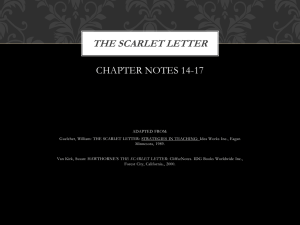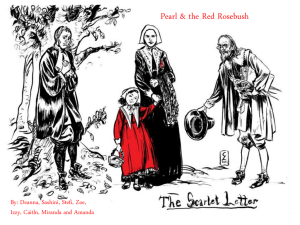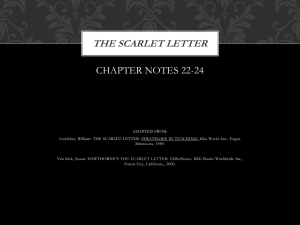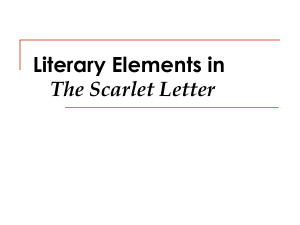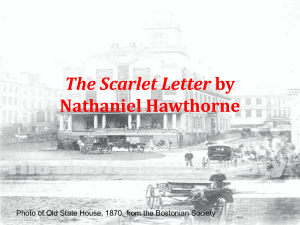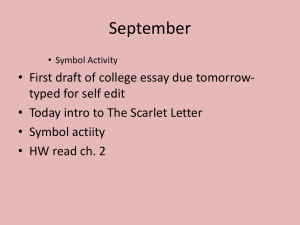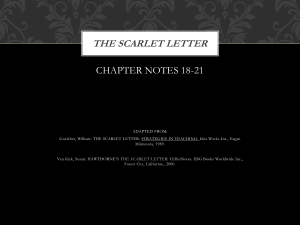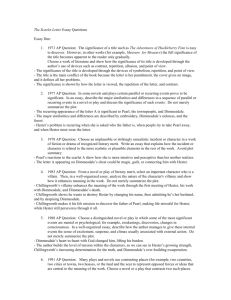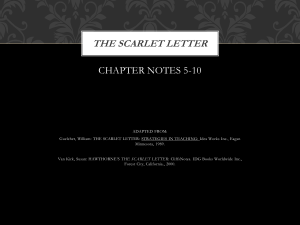Scarlet Letter Study questions and answers Chapter 1 What is the
advertisement
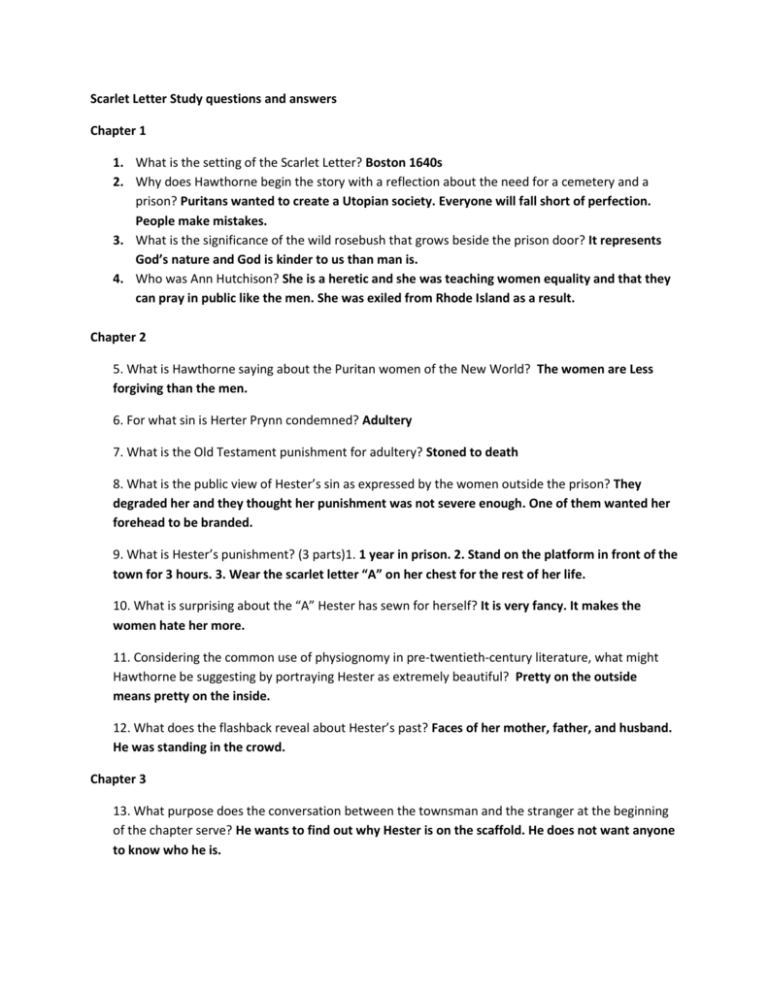
Scarlet Letter Study questions and answers Chapter 1 1. What is the setting of the Scarlet Letter? Boston 1640s 2. Why does Hawthorne begin the story with a reflection about the need for a cemetery and a prison? Puritans wanted to create a Utopian society. Everyone will fall short of perfection. People make mistakes. 3. What is the significance of the wild rosebush that grows beside the prison door? It represents God’s nature and God is kinder to us than man is. 4. Who was Ann Hutchison? She is a heretic and she was teaching women equality and that they can pray in public like the men. She was exiled from Rhode Island as a result. Chapter 2 5. What is Hawthorne saying about the Puritan women of the New World? The women are Less forgiving than the men. 6. For what sin is Herter Prynn condemned? Adultery 7. What is the Old Testament punishment for adultery? Stoned to death 8. What is the public view of Hester’s sin as expressed by the women outside the prison? They degraded her and they thought her punishment was not severe enough. One of them wanted her forehead to be branded. 9. What is Hester’s punishment? (3 parts)1. 1 year in prison. 2. Stand on the platform in front of the town for 3 hours. 3. Wear the scarlet letter “A” on her chest for the rest of her life. 10. What is surprising about the “A” Hester has sewn for herself? It is very fancy. It makes the women hate her more. 11. Considering the common use of physiognomy in pre-twentieth-century literature, what might Hawthorne be suggesting by portraying Hester as extremely beautiful? Pretty on the outside means pretty on the inside. 12. What does the flashback reveal about Hester’s past? Faces of her mother, father, and husband. He was standing in the crowd. Chapter 3 13. What purpose does the conversation between the townsman and the stranger at the beginning of the chapter serve? He wants to find out why Hester is on the scaffold. He does not want anyone to know who he is. 14. Why wasn’t Hester sentenced to death for her adultery? The town fathers took pity on her because of her age. They thought her husband was dead. 15. Where has the stranger been? What motion does he make to Hester? He had been held hostage by the Indians. He motioned for her to be quiet. 16. Who is Dimmesdale? He is Hester’s pastor and the father of her child. 17. Explain the allusion in the townsman’s telling Chillingworth, “that matter remaineth a riddle; and the Daniel who shall expound it us yet-a wanting. Reference to Daniel and the Lion’s Den. If they are going to find out who the father is, the answer will have to come from God. Chapter 4 18. Who does the stranger Hester recognized in the crowd that afternoon turn out to be? Her husband that has been gone for 2 years. 19. Why does Hester fear Chillingworth? He is a chemist. He might take revenge. 20. Again, given the use of physiognomy in literature, what is Hawthorne suggesting by Chillingworth’s aged, deformed appearance? He is immoral/evil. He has a twisted soul. 21. Explain Chillingworth’s attitude toward Hester. Calm, he says it is his fault for being gone so long. Cold/stern 22. What does Chillingworth intend to do and why? Tell the magistrate he is a doctor so he is allowed to talk to Hester while she is in prison. He wants to know the secret of the baby’s daddy. 23. What does Chillingworth ask Hester to promise? Why does she agree? He made her promise that she will never tell anyone that he is her husband. He threatened the father of the child. She will keep the identity of her baby’s father a secret. Chapter 5 24. How is Hester’s emergence from the prison at the end of her confinement different from her emergence on the day she stood in public humiliation? Crowd vs no crowd. She faced each day with a new trial. 25. What traditional dichotomy does Hawthorne begin to establish with the location of Hester’s cottage? She moved to the outskirts of town to avoid being exposed to the townspeople and their criticism. 26. Give two reasons why Hester decides to remain instead of moving to a less-restrictive colony. 1. She clings to the familiar. 2. She committed the crime of adultery in Boston so she stays to pay her penance- pay back society. 3. The father of her child lives there (She loves him). 27. How do the townspeople treat Hester? How does she react? They treat her horribly and call her names. The religious leaders stop her in the street and preach to her to make an example of her. She takes it and chooses not to react in anger. 28. How does Hester’s character evolve? She makes her living by sewing for the townspeople. She gives the money she earns to the poor. She becomes strong, compassionate and loving. 29. Describe the difference between Hester’s clothing and her child’s. Hester dresses plainly and drab in dark colors. She dresses Pearl very extravagantly. Chapter 6 30. What is the significance of Pearl’s name? Reference to the Bible. The pearl of great price. She costs her mother everything. 31. What is the significance of Pearl’s behavior? Pearl refuses to follow the rules. She is pretty. She is possessed by the devil because of her wild behavior like the wild rose bush that grows beside the prison door. 32. Explain the ambiguity concerning Pearl’s background. She does not know who her father is. 33. Hester believes that while society punishes her for sinning, God has a different reaction. How does Hester explain Pearl’s existence? She is both her blessing and a curse. Chapter 7 34. How sincerely concerned are the townspeople of Salem for the souls of Hester and Pearl? They were very sincere because they wanted to take Pearl away from Hester to teach her God’s ways instead of having her be raised by her adulterous mother. 35. Compare the Governor’s garden with gardens in Old England. What is significant about the difference? Gardens in England contained vegetables or flowers. The governor’s garden contained both. His garden cannot just be pretty, it has to be useful 36. How is Pearl dressed, and what is her dress compared to? She is dressed very extravagantly and her dress is compared to a beautiful rose. 37. Where else have we seen a rose bush in this story? Outside the prison, by the door. 38. What was its significance then? 1. Serve as a symbol of the moral of the story. 2. It sprang up from Ann Hutchinson’s footsteps. God offers comfort to the victims of sin. Pearl’s behavior is wild just like the rose bush grows wild. 39. Does it maintain the same significance here? Yes, it connects to Pearl and Pearl is a symbol of the moral. Chapter 8 40. Explain the Puritan attitude toward luxury and Governor Bellingham and the Reverend John Wilson responded to it. The laws do not apply to the rich 41. How do the magistrates react to Pearl and why? They thought she is cute. The wanted to test her on the caticism. She could not quote it and she said she was plucked from the rosebush. 42. How does Hester behave towards the magistrates and why? Hester stands up to them and defends Pearl. She calls on Dimmesdale to argue her case to keep Pearl. Chapter 9 1. A difference of opinions arises over the cause of Dimmesdale’s failing health. Compare the townspeople’s opinion to Dimmesdale’s. The people think he is so holy and the exposure to the sin of others is making him sick. He knows he is a sinner and he says that it is God’s will that he be sick. 2. Why does Dimmesdale reject Chillingworth’s offer of help? What finally persuades him to accept the offer? Dimmesdale does not want anyone to know that he is secretly punishing himself with a whip. Rev. John Wilson persuades him to accept Chillingworth’s help. 3. Describe the relationship between Dimmesdale and Chillingworth. Dr/patient-room matespriest/penatent. 4. Some people in the communityfeel God sent Chillingowrth to heal their minister, but other people have a different view. Explain the second view about Chillingworth. The people are happy to have Dr., but some people think Chillingworth is evil and he serves as a test (compared to Job) for his holiness and purity. 5. What is suggested by the names Chillingworth and Dimmesdale-Pearl? Chillingworth- Coldhearted/ Dimmesdale- not in the light but not completely in the dark, Pearl- costs her mother everything- very valuable & costly. Chapter 10 6. How do the black flowers initiate a discussion on hidden sins? The black flower is a weed that Chillingworth claims he harvested from the graveyard. He claims it grew out of a dead man’s heart because he died with some hidden sin. This is Chillingowrth using coded language to “test out” his theories and gauge Dimmesdale. 7. How does Dimmesdale’s rationale for the confessing a hidden sin support the doctrine of salvation by works rather that salvation by faith? Dimmesdale believes in salvation by works over salvation by faith. He thinks that the positive things he can do outweighs what a personally is, an unconfessed sinner. If he were to confess, he would no longer be in a position to do positive things. 8. What does Chillingworth do while Dimmesdale sleeps, and what does his action symbolize? Describe Chillingworth’s reaction and what his response reveals about his character? Chillingworth sneaks into Dimmesdale’s room and examines him in his sleep. This action symbolizes him discovering the truth about Pearl’s father. Chillingworth laughs like the devil which reveals how truly wicked he has become. Chapter 11 9. Explain the statement, “He [Chillingworth] became, thenceforth, not a spectator only, but a chief actor, in the poor minister’s interior world.” Chillingworth is becoming an actor in Dimmesdale3’s interior world because he knows Dimmesdale’s secret and he is beginning to actively torment the minister. 10. What is ironic about Dimmesdale’s incredible success as a minister? Dimmesdale’s success as a minister is ironic because Dimmesdale is an unconfessed sinner. You would not expect someone leading a sinful life to be so successful at encouraging others to live without sin. 11. Why are Dimmesdale’s public assertions of guilt ironic? His confessions are ironic because they have the opposite effect than he intended. Confessing (as he does) to sin actually makes his congregation more certain of Dimmesdale’s sinlessness. 12. Explain the ways that Dimmesdale tortures himself. 1. He beats himself with a whip. 2. He conducts multi-day fasts. 3. He has frequent sleepless vigils. 13. Comparing Dimmesdale’s current struggle with his sin with Hawthorne’s earlier treatment of Hester and her sin, what is Hawthorne suggesting about the effects of sin? Dimmesdale is suffering from the guilt of his unconfessed sin. It is causing his health to deteriorate. Hester, on the other hand, has become stronger and wiser. Chapter 12 14. How is the episode of Dimmesdale’s midnight vigil on the scaffold structurally significant? The scaffold is the framework upon which the story is constructed. It appears at the beginning, middle, and at the end of the story. This is the second time the scaffold is featured. 15. How does Dimmesdale feel as he holds Pearl’s hand and why? This is the first time he has ever touched Pearl. He feels a heart connection to her as her father. 16. Why does Pearl pull away from Dimmesdale? Pearl pulls away from Dimmsedale because he will not promise to stand with Hester and Pearl on the scaffold at noon tomorrow. Chillingworth walks up and he says Dimmesdale must be sleep walking. 17. What effect does Dimmesdale’s vigil have on his career? Dimmsedale’s vigil convinces the townspeople of his holiness by way of that further wrestling with the devil in conversation. Vocab Irony- opposite of what you expect happens. Sumptuary laws- against anything flashy (bling) that calls attention to one’s self. Hester was forbidded to make veils for brides since she is an adultress. Ignominy- public shame Physiognomy- the idea that you can tell something about a person’s moral character by analyzing their exterior appearance Edifice- wooden building-prison Utopia- Perfect world Sepulchers- tombstone Ann Hutchison- heretic- should thought women could lead prayer. Symbolism- Rosebush black flower of a civilized society/ works of man-nature/ moral lessons

